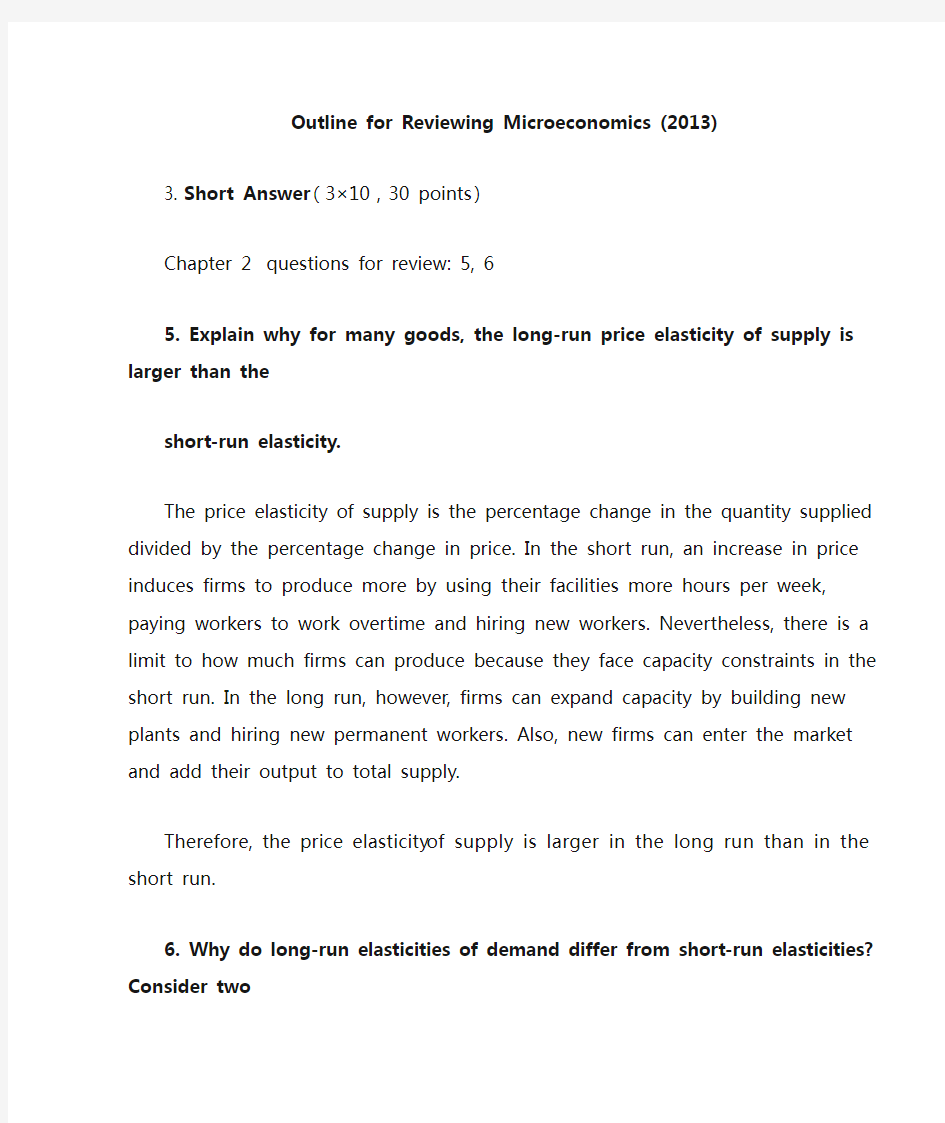微观经济学复习提纲

- 1、下载文档前请自行甄别文档内容的完整性,平台不提供额外的编辑、内容补充、找答案等附加服务。
- 2、"仅部分预览"的文档,不可在线预览部分如存在完整性等问题,可反馈申请退款(可完整预览的文档不适用该条件!)。
- 3、如文档侵犯您的权益,请联系客服反馈,我们会尽快为您处理(人工客服工作时间:9:00-18:30)。
Outline for Reviewing Microeconomics (2013)
3. Short Answer(3×10,30 points)
Chapter 2questions for review: 5, 6
5. Explain why for many goods, the long-run price elasticity of supply is larger than the
short-run elasticity.
The price elasticity of supply is the percentage change in the quantity supplied divided by the percentage change in price. In the short run, an increase in price induces firms to produce more by using their facilities more hours per week, paying workers to work overtime and hiring new workers. Nevertheless, there is a limit to how much firms can produce because they face capacity constraints in the short run. In the long run, however, firms can expand capacity by building new plants and hiring new permanent workers. Also, new firms can enter the market and add their output to total supply. Therefore, the price elasticity of supply is larger in the long run than in the short run.
6. Why do long-run elasticities of demand differ from short-run elasticities? Consider two goods: paper towels and televisions. Which is a durable good? Would you expect the price elasticity of demand for paper towels to be larger in the short run or in the long run? Why? What about the price elasticity of demand for televisions?
Long-run and short-run elasticities differ based on how rapidly consumers respond to
price changes and how many substitutes are available. If the price of paper towels, a
non-durable good, were to increase, consumers might react only minimally in the short
run- because it takes time for people to change their consumption habits. In the long
run, however, consumers might learn to use other products such as sponges or kitchen
towels instead of paper towels. In this case, then, the price elasticity would be larger in
the long run than in the short run. In contrast, the quantity demanded of durable
goods, such as televisions, might change dramatically in the short run following a price
change. For example, the initial result of a price increase for televisions would cause
consumers to delay purchases because they could keep using their current TVs longer.
Eventually consumers would replace their televisions as they wore out or became
obsolete. Therefore, we expect the demand for durables to be more elastic in the short
run than in the long run.
Chapter 3questions for review:1, 5;exercise: 2
1. What are the four basic assumptions about individual preferences? Explain the significance or meaning of each.
(1) Preferences are complete: this means that the consumer is able to compare and
rank all possible baskets of goods and services. (2) Preferences are transitive: this
means that preferences are consistent, in that if bundle A is preferred to bundle B
and bundle B is preferred to bundle C, then bundle A is preferred to bundle C. (3)
More is preferred to less: this means that all goods are desirable, and that the
consumer always prefers to have more of a good. (4) Diminishing marginal rate of
substitution: this means that indifference curves are convex, and that the slope of
the indifference curve increases (becomes less negative) as we move down along the
curve.
